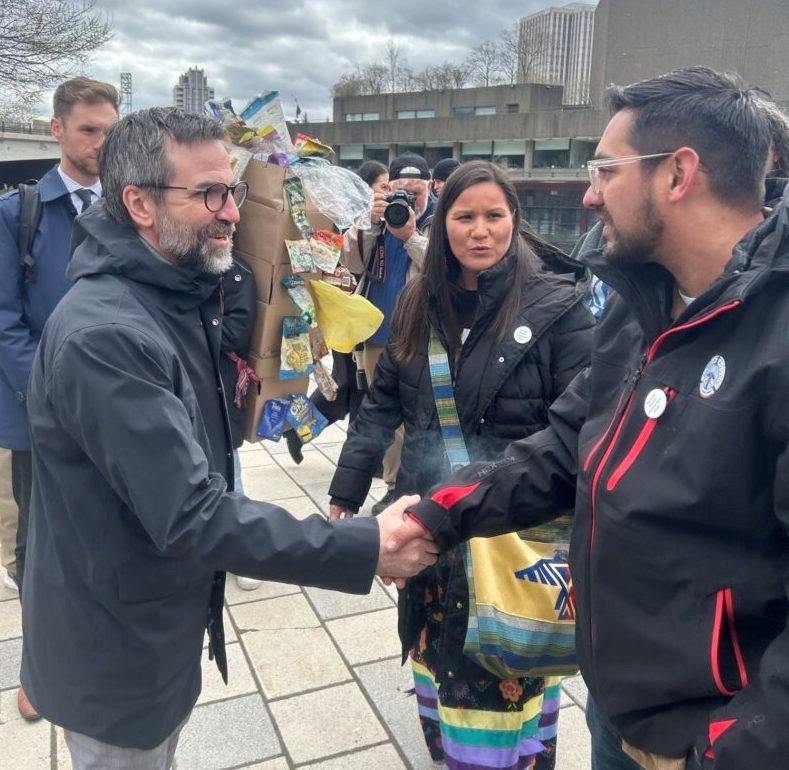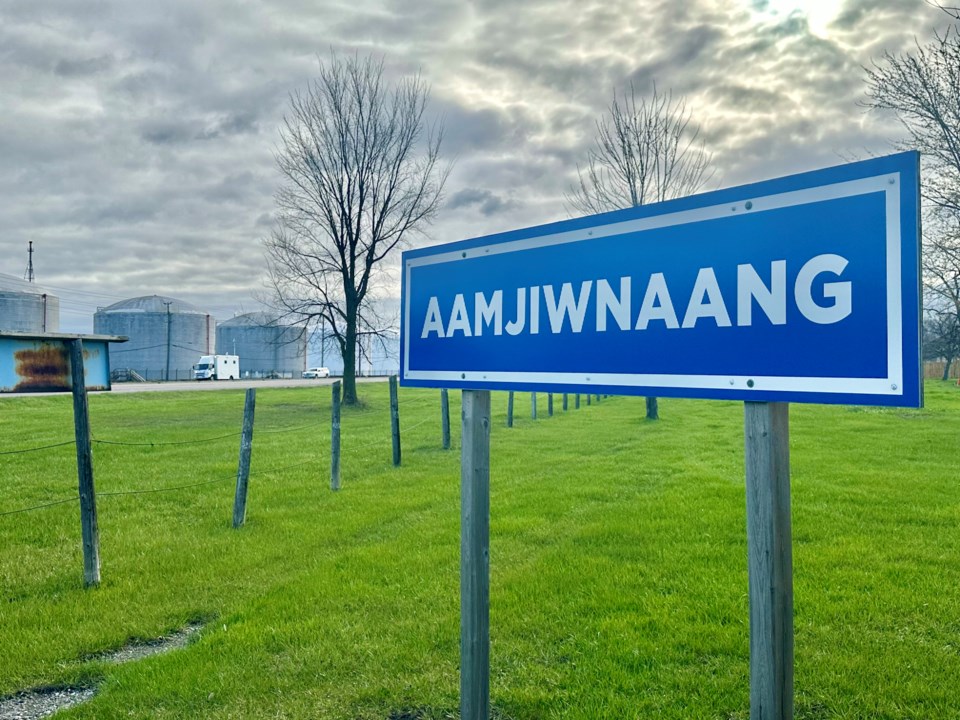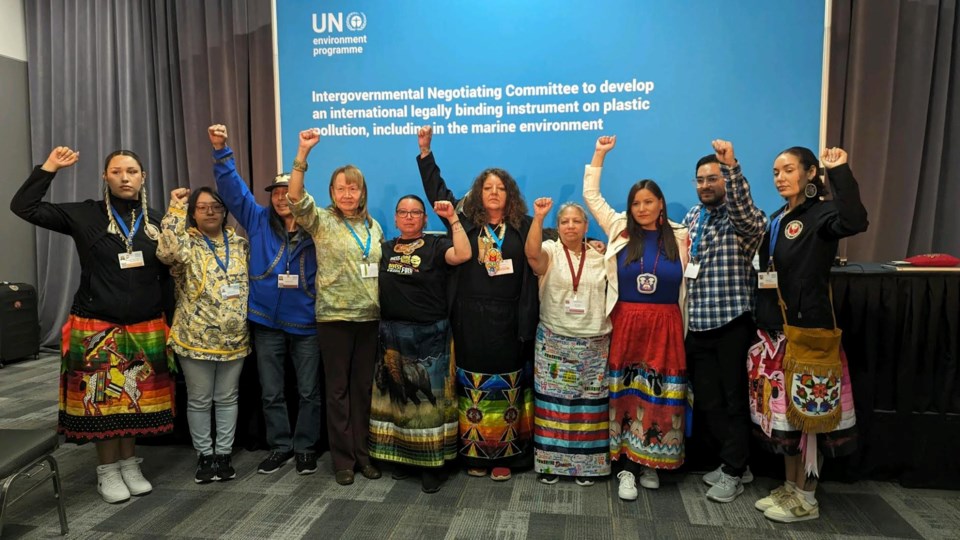Janelle Nahmabin fought back tears as she took to the global stage Wednesday with a plea on behalf of her community.
“I’m asking for our allies — scientists, health experts, anybody who’s able to come stand in solidarity — to help Aamjiwnaang First Nation,” an emotional Nahmabin told the crowd at a press conference in Ottawa, held by environmental law charity Ecojustice, to highlight the disproportionate impacts of plastics pollution on frontline Indigenous communities.
Nahmabin, an Aamjiwnaang councillor and environment committee member, is in Ottawa to attend this week’s fourth session of the Intergovernmental Negotiating Committee (INC-4) global plastics treaty talks. She also spoke at a press conference Thursday alongside the Canadian Association of Physicians for the Environment and several ENGO groups.
Originally invited as an observer, Nahmabin, joined by fellow band councillor CJ Smyth-White and environment staffer Lynn Rosales, says they’ve been given a platform at the event in the wake of last week’s reports of elevated benzene levels that led to the closure of several buildings, sent multiple residents to hospital, and prompted the Chief and Council to call for an immediate shut-down of Sarnia’s INEOS Styrolutions facility.
Over the weekend, INEOS Styrolution Sarnia announced its temporary closure following benzene levels recorded at Aamjiwnaang air monitoring stations earlier in the week that were well above the provincial standard. No community alert was issued by the company. The site uses benzene to produce styrene monomer — a basic building block of the plastics industry.
“Because of what happened last week, everyone knows about it now here — everybody,” Nahmabin told The Journal, adding that the Aamjiwnaang contingent has joined forces with groups like Environmental Defence, Society of Native Nations and Ecojustice at the treaty talks, speaking at a rally and meeting twice with the Environment Minister Steven Guilbeault.

“Spaces have been made available for us,” she added. “Every single room that we are walking into, our friends… have voiced Aamjiwnaang’s concerns and have allowed us every opportunity to become vocal; so that’s been great.”
The treaty talks are being held to develop an international legally binding instrument on plastic pollution, but Indigenous representatives say they’re being left behind.
“First Nations people need a seat at these treaty talks,” Smith-White told the press conference. “I ask you, the delegates, when you are in your negotiations, think of the frontline communities. Think of the generations of people in my community that suffer from direct effects of plastic pollution.
“This is not environmental racism — it’s environmental genocide.”
Smith-White and Nahmabin gave UN delegates and international media a glimpse into what it’s like to live on land surrounded by petrochemical industry.
“This is not environmental racism — it’s environmental genocide.”
“The light pollution, the smell, the noise, the vibrations — all of these things and more affect our ability to reconnect to who we are as Anishinaabe people,” Nahmabin explained. Every single family on Aamijwnaang has felt the effects of this pollution.
“It affects us every single day; we can’t get away from it. We don’t want to live like that anymore,” she added.
“Our community has become so climatized to industry — everyday we feel impacts — alarms going off, flares so bright that you can read a book at night,” Smyth-White said. “We have to worry about ageing pipelines that run through our community. Are they safe? Are they even
buried deep enough?”
Results of a long-awaited health study released in March show consistently higher levels of benzene around the Ada Lockridge Rogers air monitoring station, located near the Aamjiwnaang band office.

The Aamjiwnaang chief and council have made the decision to keep buildings closed and continue to urge residents to exercise caution as they wait for answers from both the Ministry of Environment, Conservation and Parks (MECP), and INEOS.
“After meeting with the MECP twice last week, we have yet to receive an update from INEOS or the MECP about the issue and how it is going to be dealt with outside of the public information that is being shared,” Aamjiwnaang band council wrote in a community update this week, adding that an additional air monitoring station has been installed in the area, specifically equipped to read for benzene, a known carcinogen.
“The monitor at the daycare has also been upgraded to do the same.”
Staff are being asked to continue to work from home.
Aamjiwnaang officials say the company has been issued several government orders requiring it to reduce benzene emissions, but problems persist.
“We are hopeful that our allies will voice our concerns with us and uplift our voices — including the City of Sarnia,” Nahmabin told The Journal. “And I’m asking for our inclusion in the potential reopening [of INEOS] and any of those discussions.
Aamjiwnaang has to be included, at every step of the way, because this is our territory,” she added. “Our voices won’t be muffled anymore.”
